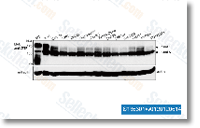aegypti strains support the conclusion that a synthetic strategy for that development of effector genes would likely be extra productive in achieving species specificity, while principal taining efficacy across geographically distinct populations. Methods Mosquito strains and rearing Three Ae. aegypti laboratory strains, LVP, CTM and RexD, had been used in this examine. The origins of your 3 strains have already been described previously. Mosqui toes had been reared in an insectary at 70 80% relative humid ity, 28 C and by using a 12 twelve h light dark photoperiod. Larvae were fed on the finely ground fish food. Male and female mosquitoes were stored collectively in cages with limitless access to water and sugar until blood feeding. Mosquitoes aged 3 5 days following eclosion have been permitted to feed on mice anaesthetized which has a mixture of ketamine and xylazine.
Forty five females of each strain have been maintained on a sugar diet and frozen promptly at 80 C 5 hours right after a bloodmeal. This time point was selected based on prior studies displaying ex tensive modifications in gene expression across strains. Ver tebrate animals were handled in stringent inhibitor erismodegib accordance with the recommendations during the Guidebook for the Care and Utilization of Laboratory Animals of your National Institutes of Wellbeing and research protocols have been accredited from the Institutional Animal Care and Use Committee at the University of California, Irvine. RNA extraction and Illumina library preparation RNA was extracted from pools of 3 female mosquitoes making use of the regular Trizol protocol.
Immediately after verifying the high quality of complete RNA samples with an Agi lent 2100 Bioanalyzer, 15 pools of sugar fed and 15 pools of blood fed mosquitoes, representing a complete of 90 mos quitoes per strain, have been mixed in equal quantities for that preparation of the paired finish Illumina library. One particular li brary per strain was constructed selleckchem Aclacinomycin A by the DNA Technolo gies Core Facility with the UC Davis Genome Center. Briefly, polyadenylated RNA was isolated from complete RNA samples applying oligo d 25 magnetic beads. As soon as the dynabead polyadenylated RNA binding was reversed chemically, the polyadenylated RNA was utilised being a template for to start with strand synthesis that was converted subsequently to double stranded cDNA. The resulting double stranded overhang fragments are finish repaired by incubation within the presence of T4 DNA polymerase and Klenow polymerase.
The polished frag ments are phosphorylated by T4 polynucleotide kinase, followed from the addition of a single A base for the three end of the blunt ended phosphorylated fragments. This A base prepares the cDNA fragments  for ligation to propri etary adapter oligonucleotides, which have a T base at their three end. Library preparation followed the workflow protocol making use of the liquid dealing with Apollo 324 robot and PrepX DNA library preparation kit manu factured by InteGenX.
for ligation to propri etary adapter oligonucleotides, which have a T base at their three end. Library preparation followed the workflow protocol making use of the liquid dealing with Apollo 324 robot and PrepX DNA library preparation kit manu factured by InteGenX.
Inhibitor Libraries
Biotechnology is the use of cells or organisms to develop products for humans.
